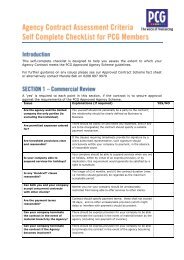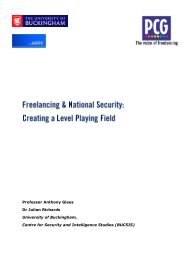Guide to Freelancing - PCG
Guide to Freelancing - PCG
Guide to Freelancing - PCG
You also want an ePaper? Increase the reach of your titles
YUMPU automatically turns print PDFs into web optimized ePapers that Google loves.
Freelancers often complain about the fact that their workload is either feast or famine. After a<br />
couple of years you will probably start <strong>to</strong> see some trends.<br />
If you are overwhelmed with work, don‟t be afraid <strong>to</strong> say, “I can‟t fit it in now, however I could<br />
start the project in three weeks‟ time”. If the client really wants <strong>to</strong> work with you, there is a good<br />
chance they will agree. If a project mushrooms, don‟t be afraid <strong>to</strong> discuss an updated budget with<br />
the client. If you state your case clearly, they are likely <strong>to</strong> agree and you will feel more motivated<br />
<strong>to</strong> do a good job.<br />
Schedule holidays, business planning and new business activities for the quieter periods and don‟t<br />
be afraid <strong>to</strong> take the odd day off <strong>to</strong> re-charge your batteries. Some freelancers build time in<strong>to</strong> their<br />
schedule <strong>to</strong> do something completely different such as a training course or even voluntary work.<br />
Variety helps you meet new people, which could lead <strong>to</strong> a new brief.<br />
When you sit down <strong>to</strong> work, concentrate on one thing. Multi-tasking has been shown <strong>to</strong> be<br />
counterproductive. A widely reported study by research firm Basex put a price tag on what they<br />
termed the modern “attention deficit”, which, they estimate, consumes nearly a third of each<br />
worker‟s productive day: “28 billion man-hours lost annually <strong>to</strong> unnecessary interruptions cost U.S.<br />
businesses $650 billion per year.”<br />
It‟s rare for anyone <strong>to</strong> be able <strong>to</strong> focus completely on one thing for more than 50 minutes, so it<br />
makes sense <strong>to</strong> work in batches of 50 minutes, or less if you find your attention wandering.<br />
Schedule five minute breaks in between and you should find you get more done.<br />
Also, rather than wasting time trawling the internet for resources, use the <strong>PCG</strong> website, help-lines<br />
and forum <strong>to</strong> answers your tax, legal and freelance/contracting related questions. Also, don‟t<br />
forget you can download useful documents such as non-disclosure agreements, contract templates<br />
and guides – saving you a lot of time and hassle.<br />
“I have <strong>to</strong> make sure that I don‟t bite off more than I can chew, taking on<br />
work that I can‟t deliver against. Conversely, it‟s important <strong>to</strong> keep<br />
enough in the forward order book. When there‟s enough work coming in<br />
and you can manage it, it‟s not stressful, but if it goes <strong>to</strong>o far in either<br />
direction it can get quite stressful – you learn <strong>to</strong> strike the right balance.”<br />
Stuart Mealing, freelance contrac<strong>to</strong>r. Read Stuart‟s case study at<br />
www.pcg.org.uk/join<br />
Here are some suggested stages in the project lifecycle:<br />
Nail down the brief before the project starts<br />
Ask the client <strong>to</strong> send you a written brief outlining their end goal – the problem they need <strong>to</strong> solve.<br />
The brief should include parameters such as deadlines, budget and responsibilities. Ask them <strong>to</strong><br />
convey the details they already know and also any areas of uncertainty. This encourages them <strong>to</strong><br />
adapt the brief as new information comes <strong>to</strong> light. If your client is very busy or is a new client, be<br />
proactive and make it easier for them by offering <strong>to</strong> discuss the project over the phone and then<br />
drafting the brief for them <strong>to</strong> adjust as required. It also helps keep momentum and increases the<br />
chances of the project actually happening. This works particularly well for smaller projects -<br />
smaller projects often lead <strong>to</strong> bigger briefs.<br />
Copyright <strong>PCG</strong> September 2011 <strong>Guide</strong> <strong>to</strong> <strong>Freelancing</strong> Version 7.0 69








